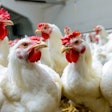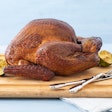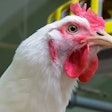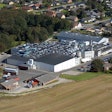.jpg?auto=format%2Ccompress&q=70&w=400)
This year, there could be from 10 to 16 million tons of distillers grains produced in the United States. It's no surprise, then, to see so many animal nutritionists looking at distillers grains as a potential ingredient.
While the corn price will continue to shape the future of both the feed industry and the ethanol business, improvements in quality of distillers grains and a better understanding of how to incorporate feed co-products into animal diets are reasons for optimism that distillers grains can have a lasting role in poultry nutrition.
Phillip Smith, poultry nutritionist, Tyson Foods Inc., Springdale, Ark., formulates broiler feeds for nine complexes in seven states and has been incorporating distillers grains into diets for several years. He shared his thoughts recently on use of DDGs in poultry diets at the International Distillers Grains Conference held in Schaumburg, Ill., in October.
Improving feed value
Smith is looking at the whole area of distillers grains from the standpoint of an integrated poultry company, Tyson Foods, which uses distillers and other kinds of co-products to improve the value of its feeds. "If we can convert something into meat cheaper, that's what we're all about trying to do," he said.
He told those at the conference that last year saw the third largest corn crop ever so that the corn price could be expected to start dropping. "But because of the ethanol pull for corn, that price actually went up in the middle of March and it's gone up ever since," said Smith.
What has the drastic hike in corn price meant for a business like Tyson? "Our average feed price for several years has been very cheap because soy and corn have been very cheap: $135 a ton US dollars for a short time. This year, I say in 2007 and since September of last year, our price has gone up to $185-$195 a ton just for ingredient cost. That's a $40 to $50 per ton increase in our feed costs at Tyson Foods," he noted. "And we'll produce somewhere between 10 and 11 million ton of feed a year. So if you took $40 or $50 a ton times 10 million tons, that's a half a billion dollars. That's a huge draw just for our one company, just for Tyson Foods."
Smith said the current pull on corn has changed the economics of the feed business, but the situation is tolerable due to the amount of corn available for feed, ethanol, exports, food and other uses. But an event, such as a drought, that upsets that supply and forces corn prices way past the $5 a bushel mark will cause feed costs to go even higher, with all interests competing for it, a scenario that would be hard on the feed industry, the ethanol industry and other businesses dependent on corn.
Recommended levels
A look at recommendations for incorporation of distillers grains into animal diets suggests U.S. poultry could use about 4 million tons of distillers. With Tyson making about 10 to 11 million tons of feed a year and incorporating distillers grains at about 10 percent, that would be about 1 million tons of distillers that Tyson foods would use alone. Tyson Foods is approximately 25 percent of the broiler industry in the United States, so Smith believes 4 million tons is a pretty good estimate of what the entire broiler industry can use. "As the grain industry gets pressure, we're going to use more distillers I'm sure, somehow," said Smith. "If we can make it and get it into the feed, we'll use it because we need more feedstuffs."
Tyson Foods did a research trial back in 2002 to determine the impact of incorporating DDGs into poultry diets. The 40-day grow out study divided birds into a control group without any distillers, and then three other group-fed diets containing 5 percent, 10 percent or 15 percent DDGS, respectively. They found no significant difference among the groups. "For some reason the 10 percent didn't do quite as well. All I can say is that's research. The other birds at 15 and 5 percent grew better than the 10. I don't know why, it's just the way they came out. The only thing significant was the weight was a little bit heavier at 15 percent," Smith.
For that trial, he included about 29 percent crude protein in the diets. "Since then I've learned a lot about feeding distillers. I may have overestimated it. The true proteins definitely ran up higher on these diets of 15 percent, I can tell you that. When I analyzed these feeds, the total protein was much higher when DDGs went into the diet," he explained. "Of course you know with that much DDGs, I'm pushing in a lot of lysine. There's a lot of lysine going into these diets. The energy I used was the energy I got out of tables, which was very critical. Kcals is 1193 kcals per pound and I still use that today, 1193 kcals for metabolizable energy per pound."
Tyson currently uses about 200,000 tons of distillers grains per year. "Could we use more? I'm sure we could if we could get it bought and get it into those locations. We have other locations where it's just too far away or there's not a plant or it's just logistically challenging to get it there, or the price is too high," Smith explained.
Smith begins with a typical base for nutrient value of DDGs. Then to match the particular situation, adjusts nutrients up or down, so the diet can be more precise, particularly as product is sourced from different plants. "And there are differences between plants, slightly. I did put in an available lysine value (of 0.56 percent). A lot of times that may be a little conservative, depending on where I'm getting it, but that's the available lysine that I'm using," Smith said. "That's very critical because DDGs are very low in lysine because corn's low in lysine. You're concentrating it."
Table 1: Typical nutritional composition of distillers grains
Relationship is important
What does Tyson expect from an ethanol plant? "If a new plant comes on, I like to get a sample of that product as soon as they feel they've got pretty good consistency. They do a better job of checking for aflatoxins than I do. I know there's aflatoxin issues, and I am concerned about that, it is a major concern. I like to see that they are monitoring it," Smith said.
After running his own analysis on the sample and seeing suitable results, he will try to get a few loads. If it looks good and there are no major flow or handling issues, it will become a part of Tyson animal feed formulations. Building a relationship with key personnel at the ethanol plant is an important part of the process. "What I want from those guys is this relationship that they're not going to send me some stuff that's out of kilter. I see a lot of people spend a lot of money on assays on every day, every week," he said. But Smith said if you've got a process going, and are consistent, even though corn can change and affect your finished product, for the most part, assaying every day or even every week is likely not necessary.
Although knowing the nutrient value of your distillers grains is important, Smith said it also needs to be kept into perspective. If DDGs are being added to a poultry diet at 5 or 10 percent levels, when proteins or amino acids or other substances vary a little, it's not going to cause a huge change.
During his presentation, Smith distributed samples of both light and dark colored distillers grains products. He told those present that it may appear as though the lysine would be quite a bit different between the two products. They were in fact, upon analysis, within 1 percent of each other for lysine adjustability estimate.
He said the darker sample may have some malted barley and other things in it that make it darker. It also had varying particle size and some syrup balls in the product compared to the product normally accepted by Tyson. "But if I can buy this product for $20 cheaper, and it's available, I may try to use some of this if I don't have issues. But what I want to do is maybe get a couple loads of this to see how it flows and handles in the feed mill."
Smith said for a typical starter diet, count on using DDGs to replace about 60 lbs. of corn and 40 lbs. of soybean meal. If meat and bone meal had been included, it may displace a portion of it due to its high protein and phosphorus levels. Plus, DDGs have a good deal of phosphorus, so may be able to replace some of the phosphorus included in the diet.
Table 2: Tyson research September 2002 results (1-40 days)
Adjusting ingredients
"There's been a lot of work on adjustable phosphorus in poultry diets looking at distillers," Smith pointed out. "It will go from 30 to 70 percent adjustability, and I would say easily 50 percent. And I know phosphorus is a big problem in the environment excretion of phosphorus, in feedlot cattle where you're feeding high levels of DDGs but phosphorus now is very expensive, $400-$450/ton. So the phosphorus in the DDGs make it worth quite a lot."
There are also other adjustments to be made. Because it's got fewer calories than corn, some additional fat should be added at the rate of around 10 pounds of fat per 100 lbs. of DDGs, although actual amounts may vary from 5 to 12 lbs., depending on the diet.
Lysine also needs to be added. Liquid lysine may go up a pound or two, dry lysine maybe three-quarters of a pound, Smith said. Limestone should also be added because distillers grains are fairly low in calcium. There may be other small changes necessary as well, particularly in amino acids.
But while sourcing distillers grains and incorporating them into diets for poultry may be one part of the puzzle, logistics loom as another huge issue. Smith points out that with rail, there is the issue of a lot of trains coming in and cars in the way if a facility is handling high speed receiving trains. That means trucking may be a better route, but unfortunately trucks will only go so far, Smith said.
Other issues surround quality of the product. "Consistency we can fix, it's the variability that kills us," he noted. For moisture level, he suggests an analysis be done to determine what you are receiving.
While some have turned to pelleting to get around quality issues, Smith said pellet quality can be a problem with throughput due to decreased quality of feed which can become crumbly because of added fat, making a softer pellet. "People can get used to it, but you've got to have the feed to where it can flow. If you put a bunch of DDGs in there, the pellet quality tends to get worse. Flowability of DDGs depends on how fine you grind it and that can affect the flowability of DDGs coming off the car. Sometimes in the summer it is a huge problem on rail cars," he explained.
Must be cost-effective
While he considers it a quality ingredient, Smith is quick to point out that Tyson isn't using distillers grains in their poultry and swine diets for any other reason than to save money. Growth of the ethanol industry has had an incredible impact on the feed business and all of agriculture. "Because of the pull for corn, it's been a big change. Feed costs have gone up for all of us$50 a ton. If I can save 50 cents a ton using distillers dried grains, I'll do it every day," he said. "But I won't do it if I won't save any money. And that's the only reason. It's not going to affect my feed costs that much, because what happens when corn goes up? Distillers goes up. So yeah, the feed for fuel deal, it's going to cost me." He added that as long as chicken prices go up in relationship to feed price plus more, it's not a problem. "When it doesn't, that could be a big problem for a lot of us and we'll be in really bad shape."
Smith says he normally reformulates his diets once a month, although he gets prices for ingredients on a weekly basis.
Despite issues of handling and quality, Smith remains optimistic that distillers grains will continue to be an excellent choice for poultry diets. "I'm very enthusiastic about these distillers in poultry diets. It's just another ingredient. And as it's grown, there's more and more tons of it and we'll continue to use it."
.jpg?auto=format%2Ccompress&crop=faces&fit=crop&h=48&q=70&w=48)



.jpg?auto=format%2Ccompress&fit=crop&h=167&q=70&w=250)












